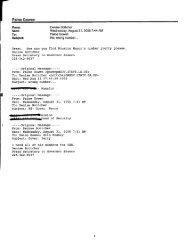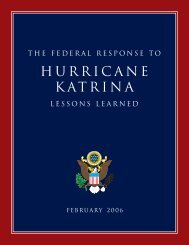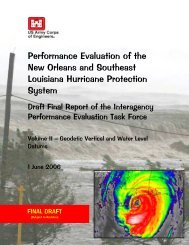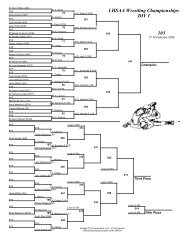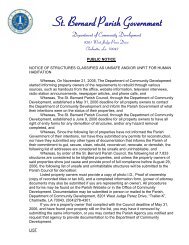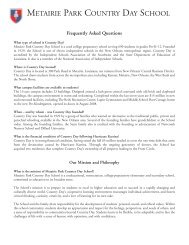IPET Report 3 Vol VIII
IPET Report 3 Vol VIII
IPET Report 3 Vol VIII
You also want an ePaper? Increase the reach of your titles
YUMPU automatically turns print PDFs into web optimized ePapers that Google loves.
�<br />
�<br />
Figure 6. Event Tree for Quantifying Risk. Underlined events (i.e., C, P, O, and B) are the complements of<br />
the respective events (i.e., C, P, O, and B)<br />
Table 1<br />
Summary of the Event Tree Top Events<br />
Top Event Description<br />
Hurricane<br />
initiating event<br />
Closure structure<br />
and operations<br />
(C)<br />
Precipitation<br />
inflow (Q)<br />
Drainage,<br />
pumping and<br />
power (P)<br />
The hurricane initiating event is mapping of the peak flood surge with waves in the study area with a hurricane<br />
rate λ. This event was denoted, hi(x,y), and has a probability of occurrence, P(hi(x,y)) and a rate of occurrence<br />
of λP(hi(x,y)).<br />
This event models whether the hurricane protection system closures, i.e., gates, have been sealed prior to the<br />
hurricane. This event depends on a number of factors as illustrated in the influence diagram. The closure<br />
structures are treated in groups in terms of probability of being closed in preparation for the arrival of a<br />
hurricane. This event was used to account for variations in local practices and effectiveness relating to<br />
closures and their operations.<br />
This event corresponds to the rainfall that occurs during a hurricane event. The precipitation inflow per<br />
subbasin is treated as a random variable.<br />
This event models the availability of power (normal) power for the pump systems. This event is modeled in the<br />
event tree to represent a common mode of failure for the pump systems, and is included in developing a model<br />
for drainage and pumping efficiency or lack thereof including backflow through pumps. The event also models<br />
the availability of the pump system and its ability to handle a particular floodwater volume. This event is treated<br />
in aggregate with drainage effectiveness and power reliability including backflow through pumps.<br />
Overtopping (O) This event models the failure of the enclosure/protection system due to overtopping, given that failure has not<br />
occurred by some other (non-overtopping) failure mode. If failure (breach) does not occur, some flooding due<br />
to overtopping could result.<br />
Breach (B) This event models the failure of the enclosure/protection system (e.g., levees/floodwalls, closures) during the<br />
hurricane, exclusive of overtopping failures). This event includes all other failures and it models all<br />
‘independent’ levee/floodwall sections. This event is treated using conditional probabilities as provided in<br />
Figure 6.<br />
<strong>Vol</strong>ume <strong>VIII</strong> Engineering and Operational Risk and Reliability Analysis <strong>VIII</strong>-15<br />
This is a preliminary report subject to revision; it does not contain final conclusions of the United States Army Corps of Engineers.



